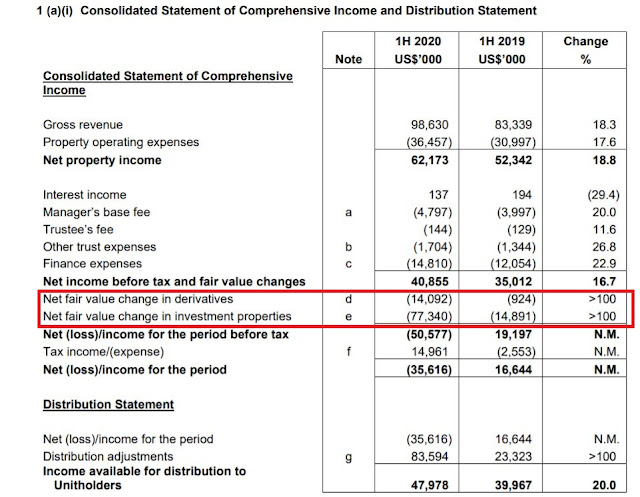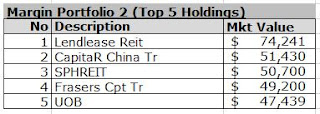Who dares win.....create your own passive income and achieve financial independence. Be in control of your own destiny.
Thursday, 21 January 2021
Fu Yu Corporation Shot Up 40%- Trio Co-Founders Sold Off Majority Stakes To Private Equity Fund And Went Into Retirement.
Tuesday, 19 January 2021
Results of FIRST REIT EGM Held on 19 Jan 2021- Overwhelming Unitholders Support On New Restructuring Deal.
 |
Saturday, 16 January 2021
Are The Distributions From Manulife US REIT (MUST) Sustainable? Clarifications from MUST's Investor Relation Team
Accounting recognition of fair valuation through P&L does create volatility in the P&L. In the case of 1H 2020 results, the accounting loss is due mainly to fair value loss of investment properties and derivatives - itself does not create a cashflow issue.
The "Capital" component of the payout isn’t distribution in excess of earnings. It’s a result of tax structuring. Both elements are in fact supported by the underlying net property income.
In terms of capital structure into US, it’s in the form of equity and shareholder loan. The shareholder loan carries a higher interest cost providing effective tax shield in addition to other onshore deductions to neutralise US taxable income to nil. The shareholder loan interest paid to Manulife US REIT is free of 30% withholding tax due to the portfolio interest rate exemption rule, upon receipt in Singapore is classified as Tax-exempt. The balance of earnings in US is extracted through shareholder loan redemption, upon receipt in Singapore is classified as "Capital".
 |
| MUST Structure |
One very interesting thing to note from the above comment is that the capital distribution of the half yearly payout is actually from property income and is actually part of recurring earnings. The only reason why it is deemed "Capital" in distribution nature is due to tax transparency planning to mitigate tax leakages. MUST extract this back via half yearly partial redemption of the shareholder loan given to the Parent REIT setup in the USA.
The investor relation team gave further insights into the MUST organizational structure being setup with regard to the above query:
"It will take a long while before the existing shareholder loans are exhausted. This will be further extended when we acquire more properties.
a) We acquire a property in US for $100, we inject capital into US in the form of $40 equity and $60 shareholder loan;
b) The property yield 6% which mean there is $6 annually (6%*$100) to be paid out from US to Manulife US REIT (“MUST”);
c) Say shareholder loan interest rate is 7%, 7%*$60=$4.2 out of the $6 will be repatriated to MUST via this route;
d) Balance of $1.8 will be extracted via repayment of shareholder loan each year. $60/$1.8 = 33.33 years. It will take 33+years for this to be exhausted.
On (c) above, effectiveness of the tax shield should reduce over time as the shareholder loan reduces but it’s a long while. To reiterate, this will be replenished with further acquisitions.
New shareholder loan can also be created when we refinance our loan as well".
The reply from MUST Investor Relation is that " On capital expenditure, the response would still be to fund it via borrowings, which is a more efficient use of capital and that we have managed gearing prudently, well within MAS gearing cap of 50%."
The 1H total distribution pay out of 3.05 cents (dividends + "Capital") will give an annualised 6.10 cents payout from its recurring earnings. This is an 8.2% dividend yield based on the last 5 trading days average price of US$0.746 per unit.
Sunday, 10 January 2021
Are The Distribution From Manulife US REIT Sustainable? Payouts Seems Greater Than Free Cashflow for Past Two Years.
 |
| Summary Income Statement |
 |
| Fair Valuation Losses From Derivatives and Investment Properties-US$92Mil |
 |
| Free Cashflow Computation |
 |
| Extract from 1H FY2020 Cashflow Statement Manulife US REIT |
Thursday, 7 January 2021
Organisational Behaviour: The meaning of "Sinecures"
The investment into the loss making Sincere Property Group in FY2020 has cost CDL a total of S$1.9 billion as at Oct 2020 which included S$895Mil for its 51% stake , S$303Mil for subscription of bonds and another S$133Mil in working capital loan. CDL will need to take into the account the loss given its 51% controlling stake to its consolidated accounts. In October last year, CDL shocked the market when it announced that a long standing director, Mr Kwek Leng Peck had resigned from the board mainly due to disagreements with regard to CDL's investment in Sincere Property Group.
It was also reported that Mr Kwek Leng Peck's resignation may have pressured the other non-executive directors of CDL who had expressed misgivings about the Chinese property group to make an exit lest they be accused of treating their board positions as "sinecures".
What is "Sinecure"?















